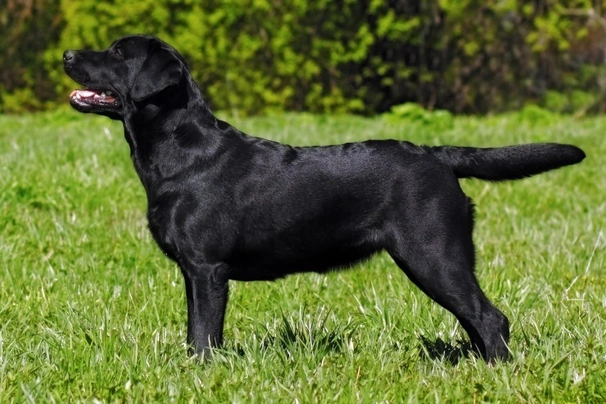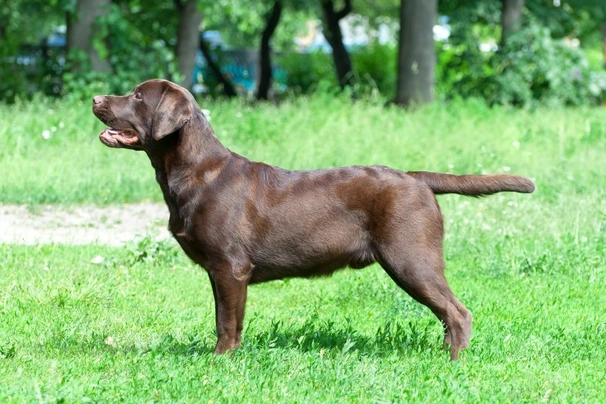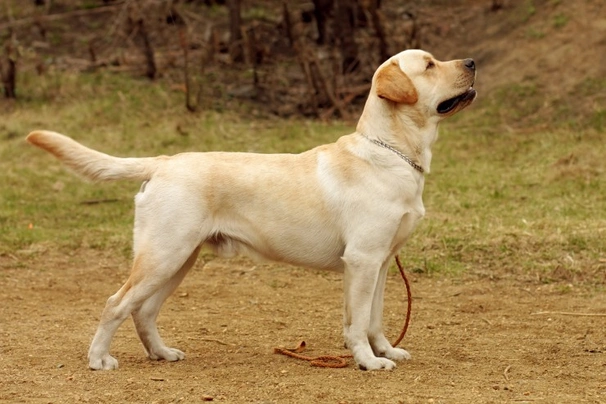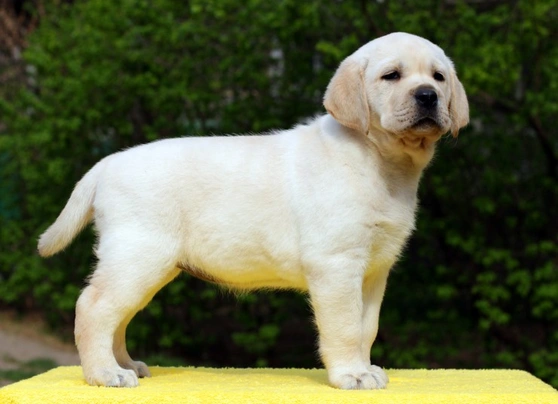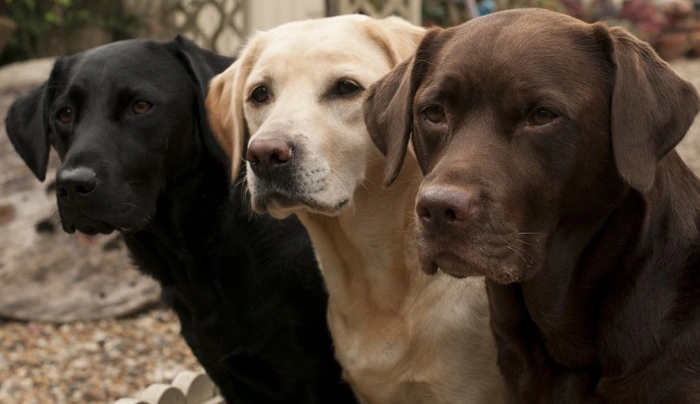Labrador Retriever
Pros
Cons
Introduction of the Labrador Retriever
The Labrador Retriever stands out as one of the UK’s most cherished dog breeds, renowned for its dependable nature and impressive versatility. Originally bred as a working gundog, this breed’s intelligence, eagerness to please, and gentle temperament have made it a perfect companion for families, sports enthusiasts, and assistance roles alike. Their friendly disposition, combined with robust bodily structure and a thick water-resistant coat, equips them to excel both in the field and the home.
Labradors are medium-large dogs known for their hearty build, powerful yet manageable energy levels, and affectionate, loyal nature. Their temperament is characterised by playfulness balanced with a keen sense of duty, making them incredible partners for tasks ranging from retrieving game to guiding the visually impaired. Their inherent kindness and patience also make Labradors highly suitable for families with children and those seeking a supportive companion.
Ideal owners tend to be active individuals or families who can provide both the mental stimulation and physical exercise this breed thrives on. The typical Labrador requires daily walks, playtime, and tasks that engage their natural instincts such as retrieving or scent work. With proper care, they adapt well to different living environments, provided their exercise needs are met to prevent behavioural issues.
When considering care, it's important to recognise that while Labradors enjoy relatively low-maintenance grooming due to their short coats, attention to nutrition and exercise is crucial given their susceptibility to weight gain. Prospective owners should prepare for lifelong commitment in terms of activity, training, and health monitoring to ensure a happy, well-rounded Labrador.
Perfect For
Active families, first-time dog owners, working roles including assistance and detection, canine sports like agility and flyball, and anyone seeking a friendly, trainable companion who excels in loyalty and versatility.
Key Considerations
Labradors require substantial daily exercise and mental engagement, careful weight management due to high food drive, and early socialisation to curb any boisterous puppy behaviours. They benefit from owners with firm but positive leadership and thrive with consistent training and companionship.
History of the Labrador Retriever
The Labrador Retriever originated in the coastal regions of Newfoundland during the 16th and 17th centuries. Initially bred to assist fishermen by retrieving nets thanks to their powerful swimming abilities and webbed feet, they later transitioned to working as gundogs retrieving game in challenging marsh and water terrains. The breed descended largely from the St John's Water Dog, crossed with other smaller water dogs and possibly importations of mastiffs by Portuguese fishermen.
Early Development
By the late 19th century, key figures such as the Earl of Malmsbury and Colonel Peter Hawker imported and selectively bred Labradors to refine their qualities in the UK. This included notable bloodlines like Buccleuch Avon, which helped establish the breed’s solid chocolate coat lineage, and Malmesbury Tramp, among other key ancestors. Their breeding aims focused on strong retrieving instincts, soft mouths for game retrieval without damage, and adaptability to various terrains.
Modern Recognition
The Kennel Club officially recognised the Labrador Retriever as a distinct breed in the early 20th century. Since then, it has maintained its status as one of the UK’s most popular breeds, consistently ranking in the top registers due to its versatility as a family pet, working dog, and show champion. Breed clubs such as the Labrador Breed Council and regional retriever clubs continue to oversee health, breeding standards, and events promoting welfare and responsible ownership. During wartime, Labradors served in various roles, including search and rescue, reinforcing their practical value and loyalty.
Appearance of the Labrador Retriever
Overall, the Labrador Retriever is a robust, balanced breed exhibiting strength without heaviness. Their physique enables them to work tirelessly in challenging environments, particularly wet and marshy conditions where their water-resistant coat and webbed feet provide excellent utility.
Size and Build
Males typically stand between 56 - 61 cm at the withers and weigh 29 - 36 kg, while females range from 51 - 56 cm in height and 25 - 32 kg in weight. Their bodies are deep-chested and powerful, with well-muscled shoulders and hindquarters to support endurance. Their feet are compact and webbed to aid swimming efficiency.
Coat and Colours
Their coat is dense, short, and water-resistant, designed to repel moisture and insulate against cold water. Accepted Kennel Club colours include solid black, solid yellow—ranging from pale cream to fox red—and solid liver, commonly referred to as chocolate. Some yellow Labradors may bear a white chest spot, permitted within the breed standard. Seasonal coat shedding peaks notably in spring and autumn.
Distinctive Features
Notable features include an otter-like tail, thick at the base and tapering, serving as a rudder in water. Their head is broad with a pronounced stop; eyes are medium-sized, brown or hazel, expressing intelligence and gentleness. Ears are pendulous, hanging close to the skull without excess length or heaviness. Noses match coat colour but may fade with age without penalty in shows.
Gender Differences
Males are generally larger and more robust, while females display a slightly more refined build. Temperamentally, females may mature earlier and sometimes exhibit a calmer demeanour, although individual variations are common. Both genders maintain the breed’s signature affectionate and eager-to-please character.
Temperament of the Labrador Retriever
The Labrador Retriever’s temperament is a cornerstone of its enduring appeal. Renowned for being affectionate, friendly, and intelligent, Labs possess a playful spirit balanced by a calm demeanour, making them adaptable family companions and capable working dogs.
Core Personality Traits
Labradors exhibit a high social drive, thriving on human interaction and forming strong bonds with their families. They are patient with children, gentle with smaller animals, and usually unaggressive towards strangers. Their eager-to-please attitude makes them highly trainable, and they respond best to positive reinforcement and clear leadership.
Social Behavior
In social settings, Labradors are approachable and friendly, rarely showing aggression. They enjoy the company of other dogs and benefit from early socialisation to foster confidence and curb potential boisterous youthfulness. Their playful energy often persists well into adulthood, supporting active lifestyles and canine sports.
Working Instincts
Instincts such as retrieving drive remain strong, reflecting their origins as gundogs. They also demonstrate a high food drive, which facilitates training but requires careful management to prevent obesity. Their pack drive contributes to their loyalty and eagerness to work alongside humans, making them excellent candidates for roles such as guide dogs, therapy dogs, and search and rescue.
Common Behavioral Challenges
Without adequate mental and physical stimulation, Labradors may develop unwanted behaviours including excessive chewing, mouthing, or barking. They can also be prone to separation anxiety due to their social nature, so gradual training for alone time and secure routines are essential to prevent stress. Early, consistent training helps channel their natural enthusiasm constructively.
Intelligence / Trainability of the Labrador Retriever
Labrador Retrievers are widely regarded as highly trainable dogs, excelling in obedience, working roles, and various canine sports due to their intelligence and eagerness to please. Training should begin early and consistently to maximise their potential and foster good behaviour throughout life.
Puppy Training Priorities
Initial training focuses on socialisation with people and other animals, establishing basic commands such as sit, stay, recall, and loose-leash walking. Early positive reinforcement with high-value treats leverages their strong food drive. Crate training and consistent routines support housebreaking and anxiety prevention during critical developmental windows up to six months of age.
Training Methods That Work
Gentle, reward-based methods are best suited for Labradors, who respond negatively to harsh corrections. Clicker training can further improve precision and clarity. Exercises incorporating play, retrieving, and problem-solving maintain engagement. Regular short sessions prevent boredom and build focus.
Advanced Training Potential
Labradors excel in advanced training such as agility, flyball, obedience trials, and service dog tasks. Their versatility allows them to succeed in scent detection, search and rescue, and therapy roles. Progressive challenges help keep mature dogs mentally and physically active, prolonging their enthusiasm and wellness.
Common Training Mistakes
Owners often overlook the breed’s need for mental stimulation and consistent leadership. Under-exercising can lead to hyperactivity or destructive behaviours. Using food rewards excessively without portion control can contribute to obesity. Inconsistency in commands or disciplinary methods may confuse the dog and slow progress.
Children and other
Labrador Retrievers are celebrated for their exceptional compatibility with children, making them one of the safest and most affectionate family companions. Their natural patience, gentle playfulness, and social nature contribute to harmonious interactions across all child age groups.
Age-Specific Interactions
Toddlers benefit from close supervision around Labradors to prevent accidental injury, while young children often enjoy interactive play that channels the breed’s retrieving instincts. Teenagers appreciate the breed’s loyalty and active companionship in outdoor activities such as hiking or running.
Teaching Children Proper Interaction
Children should be taught to respect a Labrador’s personal space, avoid rough handling, and understand warning signs of stress or fatigue in the dog. Teaching gentle petting, appropriate play, and calm behaviour around feeding times helps nurture safe relationships.
Breed-Specific Considerations
Despite their friendly disposition, Labradors are large and strong. Managing their youthful enthusiasm, especially in playful puppies, prevents children from being accidentally knocked over. Early socialisation reduces excessive mouthing, ensuring safer family environments.
Creating Safe Environments
Supervision is essential during initial interactions. Providing safe retreat areas for the dog and establishing household boundaries helps both children and pets coexist comfortably. Consistent routines and training reinforce positive habits and respect between all family members.
Health of the Labrador Retriever
Health is a critical consideration in Labrador Retriever ownership, given the breed’s predisposition to certain hereditary and acquired conditions. Their average lifespan ranges between 10 and 12.5 years, with variations influenced by coat colour genetics and lifestyle factors.
Breed-Specific Health Conditions
Labradors are prone to obesity due to a genetic predisposition affecting appetite control, notably the POMC gene variant present in about 25% of the breed. This significantly increases the risk of joint problems, diabetes, and shortened lifespan. Chocolate Labradors statistically have a reduced median lifespan of approximately 10.7 years compared to black and yellow counterparts, who average around 12 years.
Inherited eye diseases including hereditary cataracts, retinal dysplasia forms, and progressive retinal atrophy require regular eye screening from 12 months onward. Hip and elbow dysplasia remain significant concerns, monitored through radiographic scoring schemes to inform responsible breeding decisions.
Other conditions include exercise-induced collapse, centronuclear myopathy, ear infections particularly in chocolate Labs, and food or environmental allergies that can provoke chronic skin issues. Participation in the Kennel Club’s health schemes and DNA testing is vital for breeders and recommended for owners.
Genetic Testing Requirements
Mandatory tests for assured breeders include BVA/KC Hip Dysplasia and eye disease screening, with additional recommended DNA tests for centronuclear myopathy, exercise-induced collapse, and other breed-specific disorders. Results are publicly accessible for transparency and ethical breeding practices.
Preventive Healthcare Schedule
Vaccination typically starts at 8 weeks, followed by boosters and annual checks. Regular parasite control, dental assessments, and weight management plans form an integral part of veterinary care to reduce illness risks. Preventive measures help detect and address health issues early, improving prognosis.
Insurance Considerations
Due to the breed’s predisposition to costly hereditary conditions and common illnesses, comprehensive pet insurance is advisable. Premiums vary regionally and with dog age, but insurance helps mitigate financial impact from emergencies or chronic health management.
Caring for the Labrador Retriever
Labrador Retrievers require consistent care that balances grooming, nutrition, exercise, and mental engagement to maintain overall health and wellbeing. Early routines set the foundation for a long, active life.
Daily Care Routine
A typical day includes morning walks, play or training sessions, and social interaction. Grooming attention involves brushing to manage shedding and inspecting for skin issues. Mealtimes align with feeding guidelines tailored to age and activity levels. Evening activities often involve further engagement or quiet bonding time for emotional security.
Living Environment Needs
While adaptable to apartments with sufficient exercise, Labradors flourish in homes with spacious gardens where they can express their natural behaviours. Safe fencing and secure areas allow for free play, particularly important in multi-dog households. Their short, dense coats handle temperate climates well but require shelter during extreme weather.
Seasonal Care Adjustments
In summer, provide fresh water and shade to prevent overheating, especially during vigorous activity. Winter care focuses on paw protection from salt and cold surfaces, plus monitoring for joint stiffness as older dogs age. Grooming frequency increases during coat changes in spring and autumn.
Senior Care Adaptations
Older Labradors benefit from softer beds, joint supplements, and gentle exercise routines to accommodate arthritis or decreased mobility. Diets shift toward controlled calories and nutrients supporting aging organs. Regular veterinary visits become more frequent to catch age-related changes early.
Grooming of the Labrador Retriever
Labrador Retrievers have relatively low grooming demands compared to long-coated breeds, but regular maintenance is essential to keep their coat healthy and manage seasonal shedding. Their thick, water-resistant double coat benefits from systematic attention year-round.
Coat Maintenance Schedule
Weekly brushing using a wire slicker brush and short-haired rake removes loose hairs and distributes natural oils, supporting skin health. During shedding seasons in spring and autumn, more frequent brushing, up to several times weekly, is recommended to control heavy hair loss. Baths every 2-3 months help keep the coat clean without stripping essential oils.
Professional Grooming Requirements
Labradors rarely require professional grooming beyond occasional baths. However, routine paw and nail care by a professional groomer or vet can maintain comfort. Labradors should never be clipped or shaved as this damages their protective coat.
Home Grooming Techniques
At home, owners should regularly check ears to prevent infections, clean nails, and brush teeth to prevent oral diseases. Use dog-specific shampoos during baths, avoid harsh chemicals, and thoroughly dry the coat afterward. Grooming routines also provide opportunities to inspect for skin irritations or lumps early.
Common Grooming Challenges
Managing the high seasonal shedding, particularly for yellow Labs, can be challenging, requiring commitment to regular brushing. Skin allergies linked to food or environmental factors can manifest as itching or redness, and should be addressed with veterinary guidance. Prevent buildup of dirt and excess moisture in ear canals to reduce infection risks.
Exercise of the Labrador Retriever
Labrador Retrievers are high-energy dogs demanding substantial daily exercise to maintain physical health and mental wellbeing. Ideally, they require at least two hours of varied activity daily, mixing walks, play, training, and swimming to satisfy their working heritage.
Daily Exercise Requirements
A balanced schedule includes brisk walks, retrieval games to engage their strong fetch instinct, and opportunities for off-lead running in safe areas. Puppies need graduated exercise with controlled playtime to protect growing joints, while older adults benefit from moderate, consistent activity to stave off arthritis.
Suitable Activities
Labradors thrive in canine sports like agility, flyball, obedience, and dock diving. Their love of water makes swimming an excellent low-impact exercise. Scent work and tracking games stimulate their natural hunting drive. Social exercise with other dogs also contributes positively to their mental health.
Exercise Restrictions
During puppyhood, exercise should avoid high-impact or prolonged running until growth plates close. Hot weather requires shorter, cooler walks to prevent overheating. Senior Labradors require gentler, controlled activity adjusted to mobility levels.
Mental Stimulation Ideas
Enrichment activities such as puzzle toys, interactive feeders, hide-and-seek games, and training sessions help prevent boredom-induced behaviour problems. Regular mental challenges complement physical output, supporting overall contentment.
Feeding of the Labrador Retriever
Nutrition plays a vital role in maintaining the Labrador Retriever’s health and longevity. Owners must balance their dog’s high food motivation with controlled portions to prevent obesity, a common risk for the breed.
Nutritional Requirements
A diet rich in high-quality protein (ideally 20-25%) supports muscle maintenance, with moderate fats (10-15%) to supply energy. Essential fatty acids, vitamins, and minerals ensure coat and joint health. Puppies require food formulated for growth stages, while adults and seniors benefit from age-appropriate nutrients and calorie levels.
Feeding Schedule Guidelines
Puppies typically feed three to four small meals daily, gradually transitioning to two meals as they mature. Portion sizes adjust based on individual activity and weight monitoring. Treats should be given sparingly and factored into meal allowances to avoid overfeeding.
Special Dietary Considerations
Labradors may experience food allergies or sensitivities; thus, novel protein diets or elimination trials may sometimes be necessary under veterinary advice. Joint supplements and omega-3 fatty acids can support dogs prone to dysplasia or arthritis.
Weight Management
Maintaining an ideal body condition is critical to prevent joint stress and associated diseases. Regular weight checks, exercise, and portion control help keep a Labrador lean and fit. Obesity drastically shortens lifespan and degrades quality of life.
Labrador Retriever price
Based on data from the last 12 months, Labrador Retriever puppies typically range in price from £700 to £1,500. Individual breeders often offer puppies between £700 and £1,100, while licensed breeders price more commonly between £1,000 and £1,500, reflecting pedigree quality and health screening.
Purchase Prices
Prices vary depending on breeder reputation, lineage, coat colour, and whether puppies are bred for show or pet quality. Chocolate Labs and rare colour variations may attract higher premiums. Avoid purchasing puppies unseen or without proper health documentation, as reputable breeders will provide full health clearances.
Initial Setup Costs
Essential items include quality feeding bowls, collars or harnesses, leads, grooming tools, toys, and a comfortable crate or bed, which can total between £150 and £300. Puppy vaccinations, microchipping, and initial health checks add to upfront expenses.
Ongoing Monthly Expenses
Owners should budget approximately £80 to £100 monthly for food, routine veterinary care, grooming essentials, and pet insurance. High-quality nutrition and preventative healthcare contribute to maintaining long-term health and avoiding costly treatments.
Lifetime Cost Considerations
Lifetime care includes annual health checks, vaccinations, occasional professional grooming (around three times yearly), dental care, and unexpected veterinary treatments due to hereditary conditions such as hip dysplasia or eye disorders. Insurance is highly recommended to balance unforeseen health costs.
Buying advice
When considering adding a Labrador Retriever to your family, thorough research and careful selection of a reputable breeder is paramount to ensure health, temperament, and ethical practices. With Labradors’ high popularity, vigilance is necessary to avoid scams and negligent breeding.
Finding Ethical Breeders
Seek breeders registered with the Kennel Club Assured Breeder Scheme who perform comprehensive health testing and provide clear puppy history. Visiting the breeder’s facilities, meeting parents, and viewing health certificates are essential steps. Ask questions about socialisation practices, genetic testing, and the breeder’s adherence to litter limit regulations.
Health Testing Verification
Verify testing for BVA/KC Hip Dysplasia, Elbow Dysplasia, eye diseases including PRA and cataracts, and genetic screening for centronuclear myopathy and exercise-induced collapse. Responsible breeders openly share test results, which are often searchable on official Kennel Club portals.
Puppy Selection Process
Observe puppy temperament, energy levels, and interaction with littermates and humans. Puppies should be well-socialised, confident, and healthy-looking without signs of distress or illness. Avoid puppies that appear overly shy, aggressive, or isolated.
Contract and Guarantee Review
A reputable breeder will provide a written contract outlining health guarantees, return policies, and obligations for both parties. Red flags include pressure sales tactics, absence of a contract, or reluctance to provide health documentation.
Rescue and Adoption Options
Consider adopting from breed-specific rescues or shelters, which often have well-cared-for Labradors needing new homes. Adoption supports ethical ownership and gives deserving dogs a second chance.


